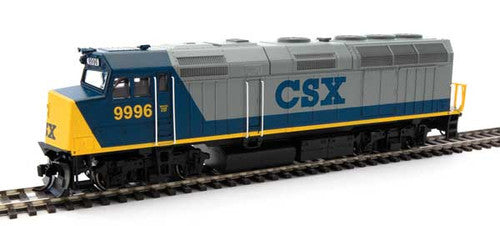The Walthers Mainline 910 - 19478 EMD F40PH CSX #9996 in HO Scale comes with ESU Sound and DCC. Note that the picture might show a different road number. These models are built for passenger duties, based on Phase 2b prototypes. They entered service in 1976 and many are still in use today. Key features include a limited - edition run of these road numbers, factory - installed vertical hand rails, molded drill starter points for grab irons (sold separately), RP - 25 metal wheels, Proto MAX(TM) metal knuckle couplers, fully assembled construction, and a 21 - Pin DCC plug. The ESU Sound system works for both DCC and DC layouts, with 4 function outputs with brightness control by CV, full DCC compatibility, 14, 28, 128 speed steps, dual - mode DC and DCC, 4 changeable air horns and 2 changeable bells via CVs, full 8 - notch prime mover sounds, compressor, and dynamic brake. It has the same powerful drive as WalthersProto(R) locos, featuring a five - pole skew - wound motor, 14:1 gear ratio, helical - cut gears for quiet and easy multiple - unit operation, all - wheel drive and electrical pickup, a heavy die - cast metal chassis, and constant and directional LED lights. Warning: When operating Walthers - branded DCC - equipped locomotives in DC mode, don't use power packs over 18V, like MRC 1300 - series power packs which have issues with our decoders. Alternate horns and bell sounds can be programmed on the sound decoder using specific CVs: Horns - CV163 = 0 for Nathan K5LH (default), CV163 = 1 for Nathan K5HLL, CV163 = 2 for Nathan K5H, CV163 = 3 for Nathan K5LLA; Bells - CV164 = 0 for Graham White E - Bell (default), CV164 = 1 for GE Steel Bell.

Using your Walthers Mainline EMD F40PH CSX #9996 is a breeze. If you're using a DCC system, simply connect the 21 - Pin DCC plug and start operating. For DC mode, make sure to use a power pack with a rating of 18V or less. Avoid using MRC 1300 - series power packs as they may cause issues with the decoder. You can customize the horn and bell sounds using the CVs provided. Just program the decoder to get the sound you like. When it comes to maintenance, keep the locomotive clean. You can use a soft brush to remove dust from the wheels, gears, and the chassis. Check the couplers regularly to ensure they're working properly. If you notice any loose parts, tighten them gently. Store the locomotive in a dry place to prevent rust and damage. With proper care, your model train will provide you with years of enjoyment.